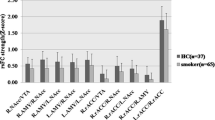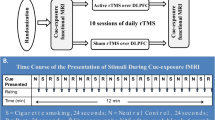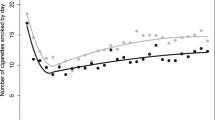Abstract
Rationale
In nicotine-dependent subjects, cues related to smoking elicit activity in brain regions linked to attention, memory, emotion and motivation. Cue-induced brain activation is associated with self-reported craving but further correlates are widely unknown.
Objectives
This study was conducted to investigate whether brain activity elicited by smoking cues increases with severity of nicotine dependence and intensity of cue-elicited craving.
Methods
Ten healthy male smokers whose degree of nicotine dependence ranged from absent to severe were investigated. Visual smoking cues and neutral stimuli were presented in a block design during functional magnetic resonance imaging (fMRI). Using multiple linear regression analysis, the blood oxygen level dependent (BOLD) response to smoking cues was correlated with severity of nicotine dependence assessed with the Fagerström Test of Nicotine Dependence (FTND) and with cue-induced craving.
Results
Significant positive correlations between the BOLD activity and FTND scores were found in brain areas related to visuospatial attention (anterior cingulate cortex, parietal cortex, parahippocampal gyrus and cuneus) and in regions involved in motor preparation and imagery (primary and premotor cortex, supplementary motor area). Intensity of cue-induced craving was significantly associated with greater BOLD activation in mesocorticolimbic areas engaged in incentive motivation and in brain regions related to episodic memory.
Conclusions
Our study suggests that severity of nicotine dependence and intensity of craving are independently associated with cue-induced brain activation in separate neuronal networks. The observed association between severity of dependence and brain activity in regions involved in allocation of attention, motor preparation and imagery might reflect preparation of automated drug taking behavior thereby facilitating cue-induced relapse.





Similar content being viewed by others
References
Addis DR, McIntosh AR, Moscovitch M, Crawley AP, McAndrews MP (2004) Characterizing spatial and temporal features of autobiographical memory retrieval networks: a partial least squares approach. NeuroImage 23:1460–1471
Andreasen NC, O'Leary DS, Paradiso S, Cizadlo T, Arndt S, Watkins GL, Ponto LL, Hichwa RD (1999) The cerebellum plays a role in conscious episodic memory retrieval. Hum Brain Mapp 8:226–234
Ashburner J, Friston K (1997) Multimodal image coregistration and partitioning—a unified framework. NeuroImage 6:209–217
Bonson KR, Grant SJ, Contoreggi CS, Links JM, Metcalfe J, Weyl HL, Kurian V, Ernst M, London ED (2002) Neural systems and cue-induced cocaine craving. Neuropsychopharmacology 26:376–386
Bradley BP, Mogg K, Wright T, Field M (2003) Attentional bias in drug dependence: vigilance for cigarette-related cues in smokers. Psychol Addict Behav 17:66–72
Brody AL, Mandelkern MA, London ED, Childress AR, Lee GS, Bota RG, Ho ML, Saxena S, Baxter LR Jr, Madsen D, Jarvik ME (2002) Brain metabolic changes during cigarette craving. Arch Gen Psychiatry 59:1162–1172
Bush G, Vogt BA, Holmes J, Dale AM, Greve D, Jenike MA, Rosen BR (2002) Dorsal anterior cingulate cortex: a role in reward-based decision making. Proc Natl Acad Sci U S A 99:523–528
Cooper DC (2002) The significance of action potential bursting in the brain reward circuit. Neurochem Int 41:333–340
Cunnington R, Windischberger C, Deecke L, Moser E (2003) The preparation and readiness for voluntary movement: a high-field event-related fMRI study of the Bereitschafts-BOLD response. NeuroImage 20:404–412
Domino EF, Ni L, Xu Y, Koeppe RA, Guthrie S, Zubieta JK (2004) Regional cerebral blood flow and plasma nicotine after smoking tobacco cigarettes. Prog Neuro-psychopharmacol Biol Psychiatry 28:319–327
Drummond DC (2001) Theories of drug craving, ancient and modern. Addiction 96:33–46
Due DL, Huettel SA, Hall WG, Rubin DC (2002) Activation in mesolimbic and visuospatial neural circuits elicited by smoking cues: evidence from functional magnetic resonance imaging. Am J Psychiatry 159:954–960
Everitt BJ, Dickinson A, Robbins TW (2001) The neuropsychological basis of addictive behaviour. Brain Res Brain Res Rev 36:129–138
Ferguson JA, Patten CA, Schroeder DR, Offord KP, Eberman KM, Hurt RD (2003) Predictors of 6-month tobacco abstinence among 1224 cigarette smokers treated for nicotine dependence. Addict Behav 28:1203–1218
Field M, Mogg K, Bradley BP (2003) Eye movements to smoking-related cues: effects of nicotine deprivation. Psychopharmacology
Fiorillo CD, Tobler PN, Schultz W (2003) Discrete coding of reward probability and uncertainty by dopamine neurons. Science 299:1898–1902
First MB, Spitzer RL, Gibbon M, Williams JBW (1996) Structured clinical Interview for DSM-IV Axis I Disorders, Clinician Version (SCID-CV). American Psychiatric Press, Washington, DC
Graham KS, Lee AC, Brett M, Patterson K (2003) The neural basis of autobiographical and semantic memory: new evidence from three PET studies. Cogn Affect Behav Neurosci 3:234–254
Grant S, London ED, Newlin DB, Villemagne VL, Liu X, Contoreggi C, Phillips RL, Kimes AS, Margolin A (1996) Activation of memory circuits during cue-elicited cocaine craving. Proc Natl Acad Sci U S A 93:12040–12045
Grüsser SM, Wrase J, Klein S, Hermann D, Smolka MN, Ruf M, Weber-Fahr W, Flor H, Mann K, Braus DF, Heinz A (2004) Cue-induced activation of the striatum and medial prefrontal cortex predicts relapse in abstinent alcoholics. Psychopharmacology 175:296–302
Heatherton TF, Kozlowski LT, Frecker RC, Fagerström KO (1991) The Fagerström test for nicotine dependence: a revision of the Fagerström tolerance questionnaire. Br J Addict 86:1119–1127
Heinz A, Siessmeier T, Wrase J, Hermann D, Klein S, Grüsser SM, Flor H, Braus DF, Buchholz HG, Gründer G, Schreckenberger M, Smolka MN, Rösch F, Mann K, Bartenstein P (2004) Correlation between dopamine D2 receptors in the ventral striatum and central processing of alcohol cues and craving. Am J Psychiatry 161:1783–1789
Hogarth L, Dickinson A, Duka T (2003) Discriminative stimuli that control instrumental tobacco-seeking by human smokers also command selective attention. Psychopharmacology 168:435–445
Kirino E, Belger A, Goldman-Rakic P, McCarthy G (2000) Prefrontal activation evoked by infrequent target and novel stimuli in a visual target detection task: an event-related functional magnetic resonance imaging study. J Neurosci 20:6612–6618
Koob GF, Le Moal M (1997) Drug abuse: hedonic homeostatic dysregulation. Science 278:52–58
Kuhtz-Buschbeck JP, Mahnkopf C, Holzknecht C, Siebner H, Ulmer S, Jansen O (2003) Effector-independent representations of simple and complex imagined finger movements: a combined fMRI and TMS study. Eur J Neurosci 18:3375–3387
Lang PJ, Öhman A, Vaitl D (1988) The International Affective Picture System (Slides). Center for Research in Psychophysiology, University of Florida, Gainsville, FL
Mogg K, Bradley BP, Field M, De Houwer J (2003) Eye movements to smoking-related pictures in smokers: relationship between attentional biases and implicit and explicit measures of stimulus valence. Addiction 98:825–836
Mucha RF, Geier A, Pauli P (1999) Modulation of craving by cues having differential overlap with pharmacological effect: evidence for cue approach in smokers and social drinkers. Psychopharmacology 147:306–313
Niaura RS, Rohsenow DJ, Binkoff JA, Monti PM, Pedraza M, Abrams DB (1988) Relevance of cue reactivity to understanding alcohol and smoking relapse. J Abnorm Psychol 97:133–152
Nyberg L, McIntosh AR, Houle S, Nilsson LG, Tulving E (1996) Activation of medial temporal structures during episodic memory retrieval. Nature 380:715–717
Oldfield RC (1971) The assessment and analysis of handedness: the Edinburgh inventory. Neuropsychologia 9:97–113
Pidoplichko VI, DeBiasi M, Williams JT, Dani JA (1997) Nicotine activates and desensitizes midbrain dopamine neurons. Nature 390:401–404
Porro CA, Francescato MP, Cettolo V, Diamond ME, Baraldi P, Zuiani C, Bazzocchi M, di Prampero PE (1996) Primary motor and sensory cortex activation during motor performance and motor imagery: a functional magnetic resonance imaging study. J Neurosci 16:7688–7698
Rizzolatti G, Craighero L (2004) The mirror-neuron system. Annu Rev Neurosci 27:169–192
Robinson TE, Berridge KC (2001) Incentive-sensitization and addiction. Addiction 96:103–114
Robinson TE, Berridge KC (2003) Addiction. Annu Rev Psychol 54:25–53
Robbins TW, Everitt BJ (1996) Neurobehavioural mechanisms of reward and motivation. Curr Opin Neurobiol 6:228–236
Rombouts SA, Barkhof F, Witter MP, Machielsen WC, Scheltens P (2001) Anterior medial temporal lobe activation during attempted retrieval of encoded visuospatial scenes: an event-related fMRI study. NeuroImage 14:67–76
Sayette MA, Martin CS, Wertz JM, Shiffman S, Perrott MA (2001) A multi-dimensional analysis of cue-elicited craving in heavy smokers and tobacco chippers. Addiction 96:1419–1432
Stein EA, Pankiewicz J, Harsch HH, Cho JK, Fuller SA, Hoffmann RG, Hawkins M, Rao SM, Bandettini PA, Bloom AS (1998) Nicotine-induced limbic cortical activation in the human brain: a functional MRI study. Am J Psychiatry 155:1009–1015
Tapert SF, Cheung EH, Brown GG, Frank LR, Paulus MP, Schweinsburg AD, Meloy MJ, Brown SA (2003) Neural response to alcohol stimuli in adolescents with alcohol use disorder. Arch Gen Psychiatry 60:727–735
Tapert SF, Brown GG, Baratta MV, Brown SA (2004) fMRI BOLD response to alcohol stimuli in alcohol dependent young women. Addict Behav 29:33–50
Taylor SF, Phan KL, Decker LR, Liberzon I (2003) Subjective rating of emotionally salient stimuli modulates neural activity. NeuroImage 18:650–659
Tiffany ST (1990) A cognitive model of drug urges and drug-use behavior: role of automatic and nonautomatic processes. Psychol Rev 97:147–168
Tiffany ST, Conklin CA (2000) A cognitive processing model of alcohol craving and compulsive alcohol use. Addiction 95 (Suppl 2):S145–S153
Tiffany ST, Conklin CA, Shiffman S, Clayton RR (2004) What can dependence theories tell us about assessing the emergence of tobacco dependence? Addiction 99 (Suppl 1):78–86
Toni I, Thoenissen D, Zilles K (2001) Movement preparation and motor intention. NeuroImage 14:S110–S117
Umilta MA, Kohler E, Gallese V, Fogassi L, Fadiga L, Keysers C, Rizzolatti G (2001) I know what you are doing. A neurophysiological study. Neuron 31:155–165
Vaidya CJ, Zhao M, Desmond JE, Gabrieli JD (2002) Evidence for cortical encoding specificity in episodic memory: memory-induced re-activation of picture processing areas. Neuropsychologia 40:2136–2143
Waters AJ, Shiffman S, Bradley BP, Mogg K (2003) Attentional shifts to smoking cues in smokers. Addiction 98:1409–1417
Weiss F, Ciccocioppo R, Parsons LH, Katner S, Liu X, Zorrilla EP, Valdez GR, Ben Shahar O, Angeletti S, Richter RR (2001) Compulsive drug-seeking behavior and relapse. Neuroadaptation, stress, and conditioning factors. Ann NY Acad Sci 937:1–26
Wrase J, Grüsser SM, Klein S, Diener C, Hermann D, Flor H, Mann K, Braus DF, Heinz A (2002) Development of alcohol-associated cues and cue-induced brain activation in alcoholics. Eur Psychiatry 17:287–291
Yücel M, Wood SJ, Fornito A, Riffkin J, Velakoulis D, Pantelis C (2003) Anterior cingulate dysfunction: implications for psychiatric disorders? J Psychiatry Neurosci 28:350–354
Zubieta JK, Heitzeg MM, Xu Y, Koeppe RA, Ni L, Guthrie S, Domino EF (2005) Regional cerebral blood flow responses to smoking in tobacco smokers after overnight abstinence. Am J Psychiatry 162:567–577
Acknowledgements
This study was supported by the Deutsche Forschungsgemeinschaft (DFG) grant Sm 80/1-1. The results of this article are part of the Ph.D. thesis of Mira Bühler. We further appreciate assistance by Jörg N. Nikitopoulos in preparing the visual stimuli for this study and by Anne-C. Karow in fine-tuning of the manuscript.
Author information
Authors and Affiliations
Corresponding author
Additional information
M. Smolka and M. Bühler contributed equally to this work.
Rights and permissions
About this article
Cite this article
Smolka, M.N., Bühler, M., Klein, S. et al. Severity of nicotine dependence modulates cue-induced brain activity in regions involved in motor preparation and imagery. Psychopharmacology 184, 577–588 (2006). https://doi.org/10.1007/s00213-005-0080-x
Received:
Accepted:
Published:
Issue Date:
DOI: https://doi.org/10.1007/s00213-005-0080-x




